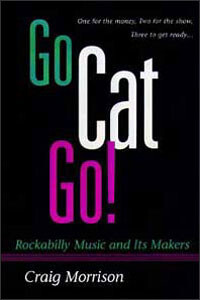 Rockabilly music is a curious creature. It is one of the most vibrant and durable musical styles ever to be born in America, but it’s more popular in Europe than in its homeland. It’s difficult to define, but everybody knows it when they hear it. And it wasn’t recognized as a distinct genre until after it had nearly died out and been revived.
Rockabilly music is a curious creature. It is one of the most vibrant and durable musical styles ever to be born in America, but it’s more popular in Europe than in its homeland. It’s difficult to define, but everybody knows it when they hear it. And it wasn’t recognized as a distinct genre until after it had nearly died out and been revived.
Craig Morrison, a Canadian musician, teacher and ethnomusicologist, has written an exhaustive study of the music, its origins and its practitioners. Unfortunately, Morrison’s writing style lacks the liveliness of its subject.
Rockabilly is a distinct subgenre of rock ‘n’ roll. In its purest form, it is made by a trio comprising an acoustic bass, rhythm guitar and electric lead guitar. Other instruments, particularly piano and tenor sax, are acceptable. Its lyrics usually reflect the concerns of young people, particularly of the working class — sex, cars, and rebellion against authority figures — and are delivered in an emotionally charged manner, with lots of vocal tricks like stuttering, nonsense syllables, and repetition.
Rockabilly’s heyday began with Elvis Presley’s recording of “That’s Alright Mama” in July 1954, and in its first incarnation, it didn’t survive the Fifties. It has since undergone a major revival and become one of the most popular types of pop music in much of Europe.
In a sense, rockabilly as a distinct style was created by accident. Other rock ‘n’ roll bands across the country found that they could hop on Elvis’s bandwagon by performing in a similar manner. Indeed, for a while, nobody could have a hit who didn’t perform rockabilly music. The name “rockabilly” was only one of numerous apellations attached to this new, wild music and its performers in those heady early days, when nobody could quite get a handle on it. Of course, part of the problem was that it was “Black” music performed by whites, but to acknowledge that would have seriously compromised its popularity at the time.
It wasn’t until a decade or more after the first wave of rockabilly was overcome by the British Invation that members of the Post-World War II Baby Boom generation, in a fit of nostalgia for the music of their youth, brought about a revival of the genre. Suddenly, in the mid- to late-Seventies (particularly after Elvis’ death in 1977), the veterans of the Fifties scene such as Jerry Lee Lewis, Carl Perkins, and Sonny Burgess found themselves once again in demand as performers. They were followed by a cadre of revival and neo-rockabilly bands, whose popularity continues in some quarters today.
All of this and more, Morrison details thoroughly in his book. It’s not nearly as much fun to read as rockabilly is to listen to, though. The book reads like a textbook; which would be acceptable, I guess, if it were organized as well as a textbook. The book does have a framework. It starts with introductory chapters to define rockabilly and set it in its place in pop music history, and then its actual birth and ascent at the hands of Mr. Presley.
Subsequent chapters cover the rockabilly artists and music that came out of Memphis, Nashville, Louisiana, Texas and California; women in rockabilly; the revival, and where the veterans are now. Those who survive, that is.
But within the chapters, it’s hard to figure out the organizational scheme. In the Texas chapter, for example, why does Sid King (who?) come before Buddy Holly? In the California chapter, The Collins Kids and Glen Glenn come before Eddie Cochran. Were they more influential, more popular, or merely chronologically first? The book may give clues, but doesn’t spell it out.
The best chapter is the conclusion, which wraps up the subject nicely. This suggests to me that it might better have been reworked and used as an introduction, instead.
The book contains a fairly thorough discography. I think it might have been more useful if organized in chronological order rather than alphabetically.
The strongest point against the book is that it’s missing 33 pages in the early chapters, between pp. 18 and 51. The publisher sent us a second copy, apparently without checking to see if it was similarly flawed — it was. So I can’t in good faith recommend that anybody buy this volume until being assured that a complete version is available.
In spite of the author’s colorless and stilted style, Go Cat Go! could be a useful volume for those interested in the history of American pop music. But the book as it stands is fatally flawed.
(University of Illinois Press, 1996)
